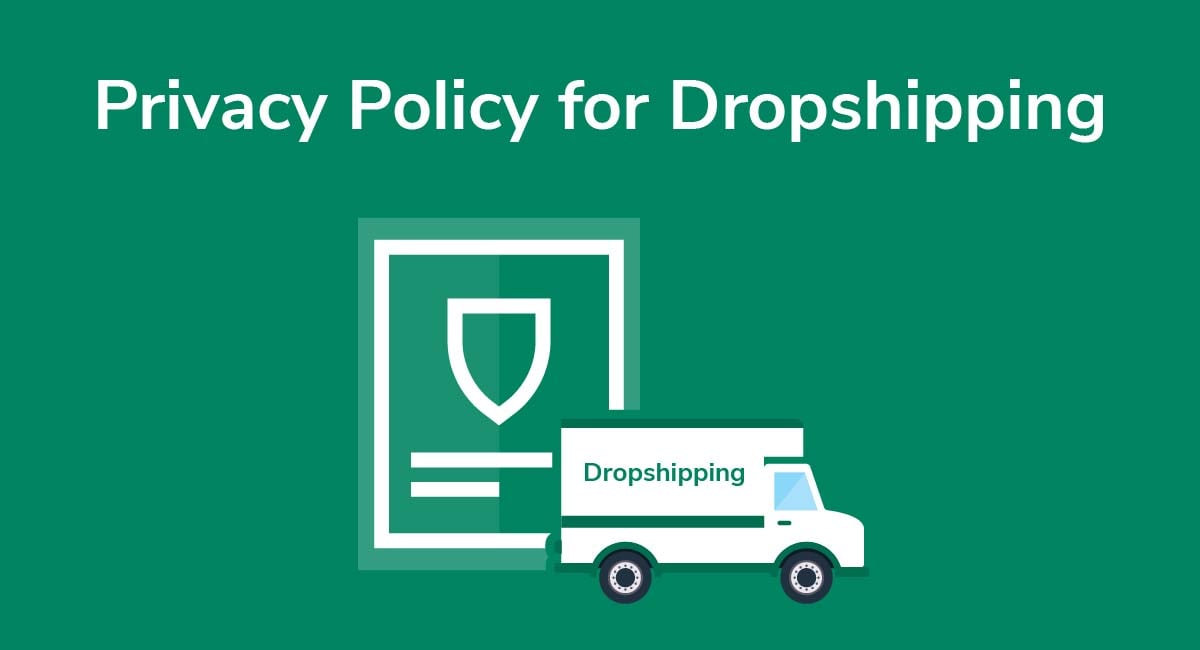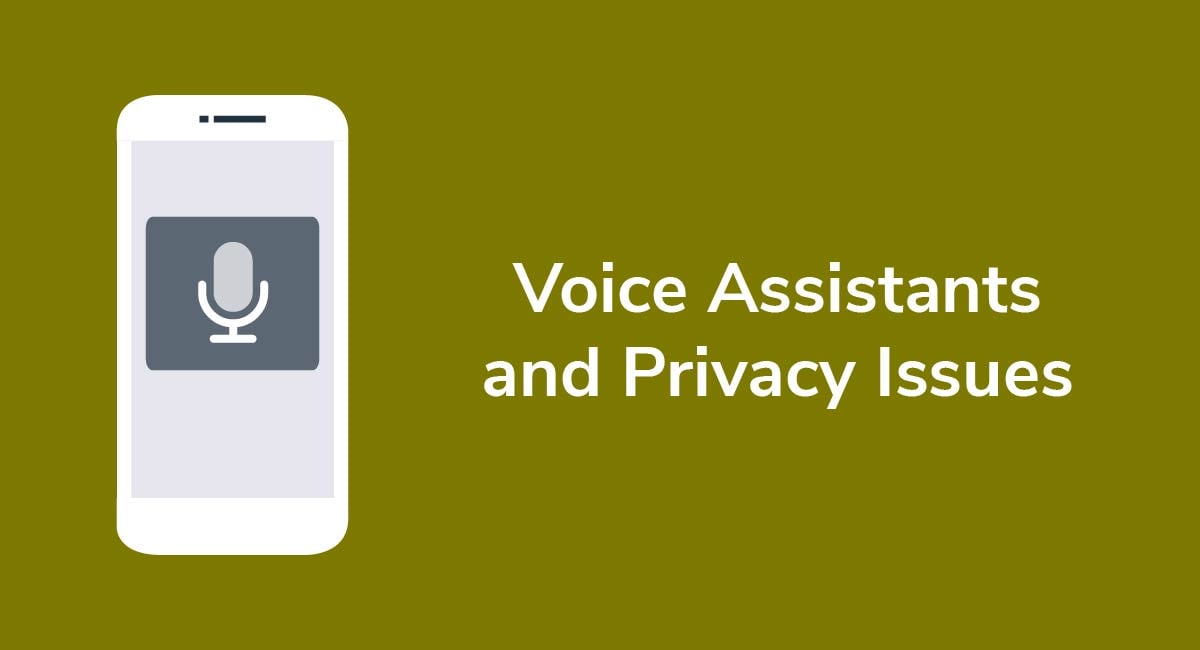AdMob, Your App and Your Privacy Policy
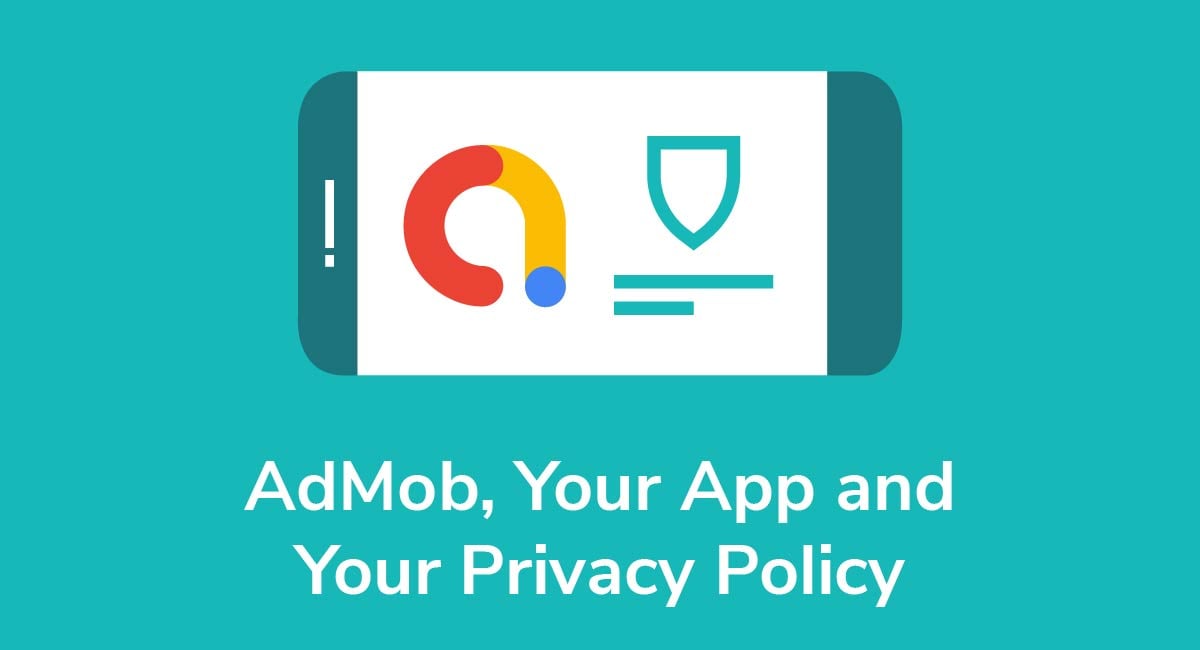
So you've finally finished building your lovely new app and it's ready to be unleashed on smartphone and tablet users everywhere.
Your app is everything you hoped it would be because you've done everything you could to ensure its integrity, effectiveness, relevance, and smooth operation. But if costs aren't somehow recouped you can kiss your career as a developer good-bye.
So, how can you monetize your app while keeping it compliant with legal and third-party requirements?
There are basically four main to make money from an app these days:
- Charge people to download it.
- Let people download it for free but later charge them for other features.
- Sell products from the app.
- Let people download it for free, with all its extra features, but sell advertising space on your app.
Making Money from a Free App with AdMob

Just go to AdMob and create an account. Say which kind of platform your app is built for (e.g. Windows, Android, iOS, etc.). Once you've created your account you can download the Software Development Kit (SDK), which you then integrate into your app. Once that's done, ads from businesses will immediately start appearing in your app. It's that simple.
AdMob also gives you access to Google Analytics to help you see which improvements to your app might prove the best use of your time and money.
Before you start thinking that this whole paradigm gives away too much of your power and control, hold your horses: You retain control of who can advertise on your app. Do you belong to PETA? Scratch ads for fur coats. Are you a gun control zealot? No gun ads. Is your app created to promote tranquility? Just say no to ads for screamo music.
Simply put, by building this advertising platform into your app you allow it to earn ad revenue from a network - or even a network of networks - of advertisers who've signed on with Google to purchase advertising space on apps, including yours.
If your app hosts ads relevant to its users, they'll click on those ads to find out more. The more clicks your app receives, the more money you make.
AdMob Privacy Policy Requirements

AdMob offers your business an opportunity to grow, if you're willing to comply with its Terms of Service.
Note that AdMob is governed by the AdSense Terms of Service as part of Google's Mobile Ads SDK:

One of the requirements of the Terms of Service agreement is that developers have a clearly labeled and easily accessible Privacy Policy:

If your clients' information will be collected by a third party that you've integrated into your app (such as AdMob), you're responsible for ensuring that your clients are aware of this and have the power to allow it - or not.
AdMob is an advertising platform, and advertising platforms make use of clients' personal and impersonal information in order to target those most likely to be interested in their products. And by "personal information" I don't mean who your biggest high school crush was. The advertisers couldn't care less about that unless it might help them sell you cologne.
The information to which the platform is privy might be something as simple as the fact that you're using this particular app. Knowing this gives them power, but a power which the authorities have decided must be strictly limited to the task at hand, with clear statements to that effect.
Along with AdMob itself and international laws, most of the larger app stores now require you to have a solid Privacy Policy in place before they'll allow you to list your app in their stores.
Updating Your Privacy Policy

There are a number of reasons for updating your Privacy Policy if you're using AdMob, or creating one if you don't have one yet:
- You need to protect yourself from liability. Most countries now have privacy laws to protect mobile app users.
- AdMob explicitly requires it.
- As a business owner, you need to inspire trust in your clients.
The following three elements are essential in every Privacy Policy:
Need a Privacy Policy? Our Privacy Policy Generator will help you create a custom policy that you can use on your website and mobile app. Just follow these few easy steps:
- Click on "Start creating your Privacy Policy" on our website.
- Select the platforms where your Privacy Policy will be used and go to the next step.
- Add information about your business: your website and/or app.
- Select the country:
- Answer the questions from our wizard relating to what type of information you collect from your users.
-
Enter your email address where you'd like your Privacy Policy sent and click "Generate".

And you're done! Now you can copy or link to your hosted Privacy Policy.




1. Clarity
The Privacy Policy for your app must be clear, concise, easy to read and easily understood. If your bright nine-year-old niece doesn't get it, you probably need to find another way to phrase that sentence.
This is where you go back to good-old fashioned writing rules. Brevity is king. Remember that Shakespeare rarely used words longer than three syllables. Never use a big word when a little one will do and never use four words when one is enough. You may at first pale at the task of reducing those reams of fine print legalese to a few sparse paragraphs, but one consolation is that the writing will surely be better.
More importantly, people will actually be able to read and understand it. They'll know what they're getting into and will have the freedom to accept or reject your app based on accurate information.
2. Obviousness
This step may do the most to protect you from liability. It requires that your Privacy Policy or the link to it be posted in such a way that the client can't later claim they couldn't find it.
Most apps post the link to their Privacy Policy on the landing page where the app can be downloaded. Others take security one step further by requiring clients to agree to the terms of the policy before downloading the app.
It's certain that many clients will simply wave this aside and download your app without bothering to read your Privacy Policy. That's not your problem. The important thing is, you tried hard and you stuck to the rules.
You need to make your Privacy Policy accessible from within the app as well via a Legal or About type of menu.
3. Transparency
The Privacy Policy must tell clients if, how, and what personal information will be gathered from them - and how it will be used. It must explain to clients or potential clients that third parties (advertisers, in this case AdMob) will be using data collection technologies to gather their personal information for the specific and limited purpose of marketing products.
To understand the importance of transparency, imagine yourself in a business relationship in which you've given your trust to your partner. In other words, you don't believe that this person will harm, trick, or exploit you to their advantage.
How are you going to feel when your partner stops speaking to you, doesn't come to meetings and gets defensive when you ask to see accounts? Naturally you're going to start thinking they're hiding something.
Now let's suppose you find a business partner who seeks you out often, discusses all transactions with you and never has to be asked to show you their records? What if when they make a booboo they tell you right away instead of trying to cover it up? That person will inspire you with ongoing trust and give you a sense of security. All things being equal, your relationship with this partner is more certain to last.
That's the power of transparency. Embrace it: Your clients deserve nothing less.
A Few Good Examples
Here are a few examples of easy to read, well-organized and transparent Privacy Policies.
Intermorphic, a company in England that produces music and relaxation apps, summarizes its Privacy Policy by assuring potential clients that their privacy will be respected, then provides a list of links directed to the needs of specific user groups. It's beautifully simple.
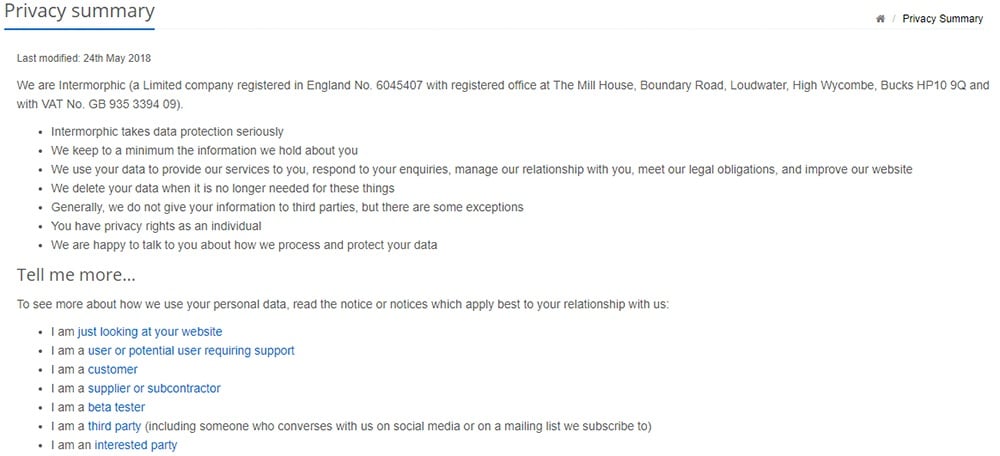
Another model is represented by the Avast. The Privacy Policy's main page begins with a brief intro and then a list of hyperlinked topics related to how private information is gathered, stored, and used:
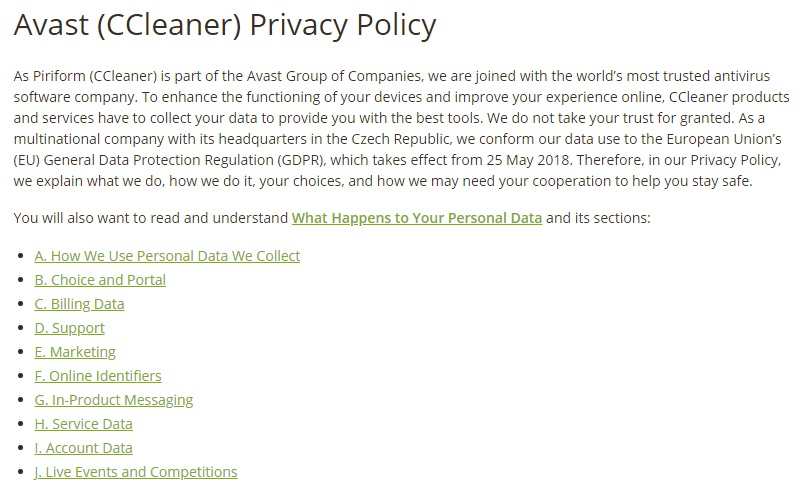
This is followed by a list of simply labeled hyperlinks leading you to specific topics in the Policy, including the company's commitment to client privacy as well as general information on topics like privacy laws and how consumers can protect their own privacy..
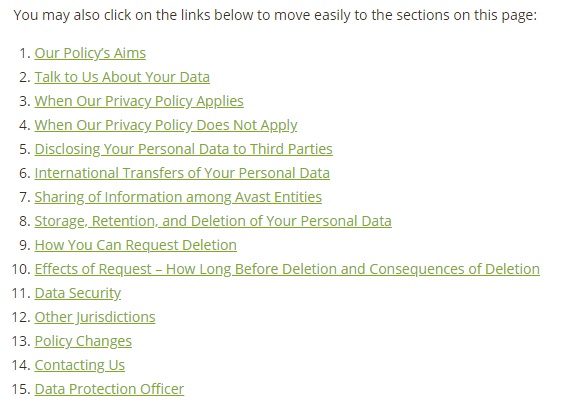
Game app producer Frogmind places an invitation to email questions in the first paragraph.

It then proceeds to outline a series of the most important issues in a way that's broken down into short, easy to follow paragraphs, sections and sentences.
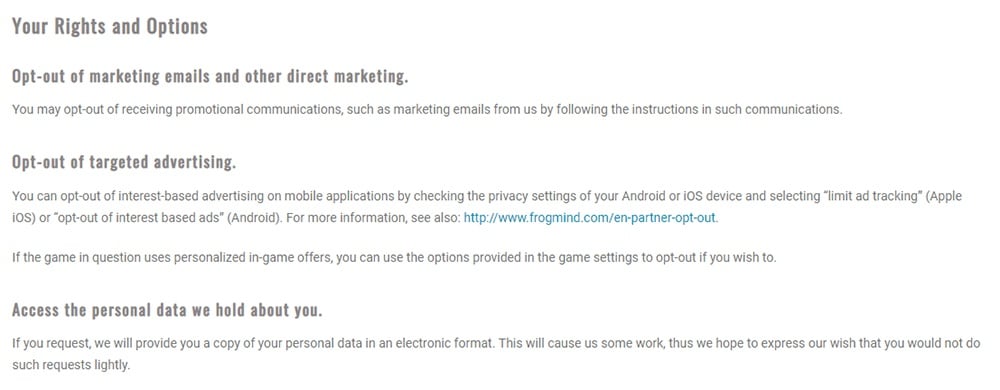
Everything is simple and clear, and the entire thing doesn't take a lot of time to read.
The Privacy Policy of Hobbyist Software hooks the reader right away by taking their side, with a touch of humor:

They then provide a list of 14 need-to-know facts, each written to be short and to the point. Note the mention of and linking to AdMob in point 6:
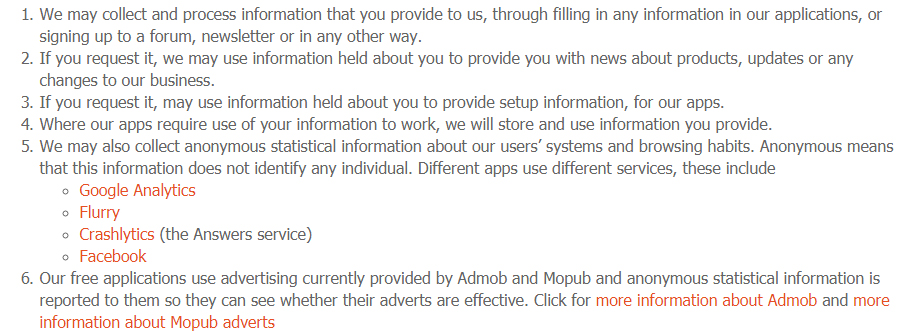
So there you have it. Armed with what AdMob - and practically the whole world - requires of you in terms of privacy protection you can now tackle the task of policy creation, or updating of your existing Privacy Policy.
Four Tips
- Study AdMob's Terms of Service.
- Remember to aim for clarity, obviousness, and transparency.
- Take a careful look at what your app provides and to whom, and try to tailor your Privacy Policy to the needs of your customer base while complying with the law.
- Take a look around at the structure and format of other policies to help you decide which approach is best for your company.
